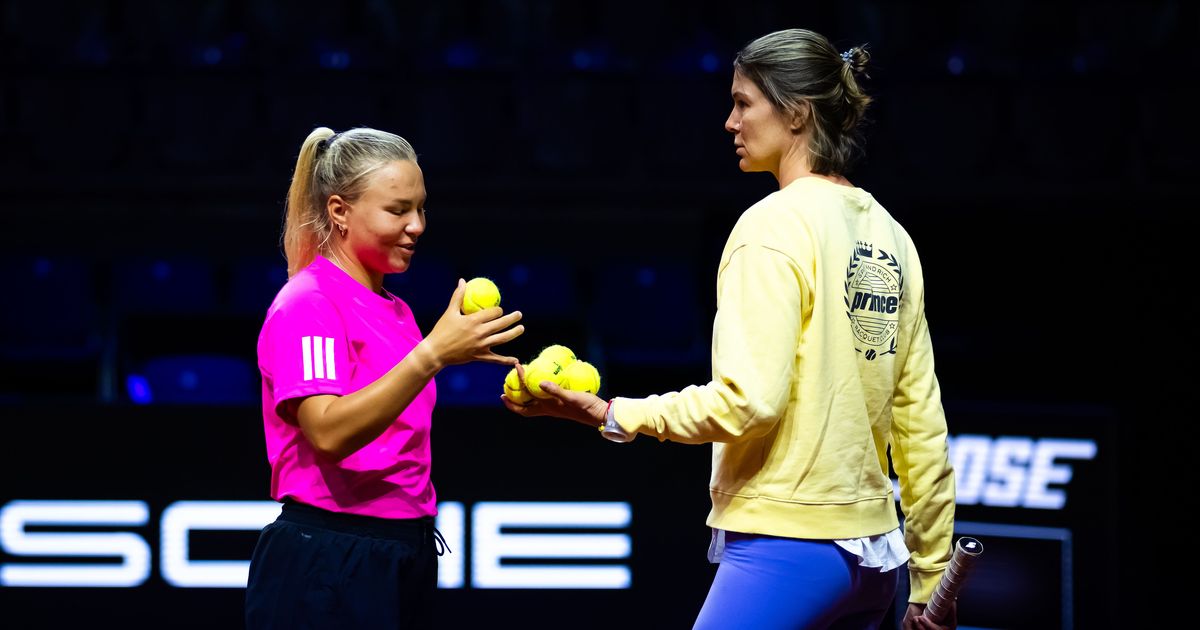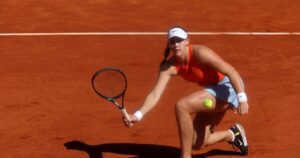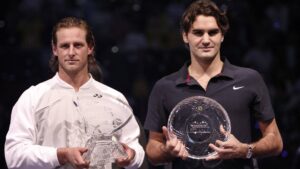
MADRID — Dinara Safina, the former Hologic WTA Tour No. 1, is well aware that it’s far easier to play than to watch. And yet, she recently signed up to return to elite tennis as a coach.
Safina may have been rethinking that decision here on Friday when Diana Shnaider and her partner Mirra Andreeva were scuffling out on the Mutua Madrid Open’s Court 5. Eventually, they overcame Nicole Melichar-Martinez and Liudmila Samsonova — in a 12-10 match-tiebreak.
To see Safina twisting and grimacing in her seat was difficult. Heart attack?
“Almost,” she said, shaking her head.
Said Shnaider: “I can imagine that. I almost had one, too.”
Safina, one of the best clay-court players of her day, is back on the red dirt, working with Shnaider, who turned 21 earlier this month. She’s ranked No. 13, and Saturday she dropped a pristine 6-0, 6-0, 44-minute victory on Anastasija Sevastova.
It was Shnaider’s first shutout at WTA Tour level (she did it twice in ITF events in Kazakhstan and Turkey), and it sends her into a Monday Round of 16 match against either No. 2 Iga Swiatek or No. 31 Linda Noskova.
How did Safina and Shnaider connect?
Shnaider was coached by Igor Andreev until the end of last season and then her father, Maxim, a lawyer, took over temporarily. When Shnaider began searching for a new coach earlier this year, her mother, Yulia, contacted 2004 French Open champion Anastasia Myskina for some ideas. Myskina, who is good friends with Safina and a colleague at the sports channel “Bolshe!” — they talk almost every day — suggested Safina. It wasn’t long before Yulia texted Safina.
“They asked me if I can come to Dubai, and I said it’s very fast, I cannot change my plans,” Safina told wtatennis.com. “Then with U.S. tournaments [Indian Wells and Miami]I have no visa. So I said, `OK, I’m good for clay-court season.’
“I spoke on it with my family. For me, it was the perfect timing.”
Shnaider said she’s enjoying the practices and spending time together. Safina’s biggest asset, she added, is her deep well of experience as a top-notch player.
“A lot of mental strength, focusing on the right things,” Shnaider said. “How to manage emotions better. It’s just small adjustments, where to put the ball better in the court. Stepping in to be more aggressive. Seize opportunities, stepping in, coming to the net.
“I would say mostly not pushing myself down into negative emotions. If I’m doing a mistake, not to think about it. Finding what I did wrong, finding a solution and keep focused on the next ball. Not to be too harsh on myself.”
Safina said it’s been interesting experiencing tennis from the other side.
“I don’t know if it helps her, doesn’t help — looks like sometimes it does, sometimes it doesn’t,” Safina said. “Sometimes she listens, sometimes she doesn’t listen.”
A reporter pointed out that Shnaider is still only 21 and in her third season of playing tour matches.
“Not a kid, come on,” Safina said. “We have to be honest. It’s an adult like this. Slowly, she has to grow up and become a woman to be a little more disciplined.”
Shnaider doesn’t deny it.
“I’m always listening to her, just sometimes it takes time to do what she’s asking for,” Shnaider said, “I’m never like, `Whatever.’
“I understand what she wants but sometimes it’s just a little bit hard. It’s not like — click — you can just change yourself.”
Safina retired in 2011, atypically early at the age of 25, with a chronic back injury.
What’s she been doing since?
“Actually,” she said, sighing, “living life.”
In the 14 years since, Safina’s had a varied and eclectic series of experiences. She went back to school and earned a law degree. She worked in player relations for tournaments in Madrid, Moscow and St. Petersburg, and was even an operations director for an IT company. That last one required office hours, which didn’t agree with her. She also lived in New York City for a spell and coached Anhelina Kalinina.
Her biggest issue for nearly an entire decade was a battle for control — of herself.
“I went through a lot of things — I never spoke like loudly about this,” Safina said. “I gained a lot of weight and I was struggling with binge eating disorder. I had it for quite a long time.
“Ups and downs. Depressions, struggling with it. I couldn’t find myself. Slowly, I started to get out of there.”
That was 2020.
“And now I’m here,” Safina said smiling.
One month ago, she and her brother, Marat, were most famous for being the first (and only) brother-sister combination to reach the No. 1 ranking on their respective tours. Today, they are both coaching Top 15 players, as Marat recently joined the team of Andrey Rublev.
Fun fact: Both player and coach have won a silver Olympic medal — Shnaider with Mirra Andreeva last summer in Paris and Safina in singles in 2008 Beijing.
The agreement with Shnaider only extends through the clay season. After Roland Garros, they’ll discuss the future.
“We’ll see,” Safina said, “It’s still to talk about.”
Shnaider sounds enthusiastic.
“I love how it’s going so far,” she said. “How she sees my game. What she wants me to improve and get better.
“By the end of — or maybe before [Roland Garros] — we will sit and talk, maybe agree. Give our thoughts to each other. For me now I’m just enjoying, and I hope she is, too.”
Source: https://www.wtatennis.com/news/4254516/safina-steps-back-into-the-arena-this-time-in-shnaider-s-corner


